Many forms of dog training exist. One successful positive training method is the "Lure and Reward".
When it's time to focus on training your dog, it's important to find a training technique that is easy for you to learn, fun to do with your dog, and one that your dog understands as you teach him. There are many different training techniques available; in fact, if you call a number of dog trainers in your area, you will find that each has a different technique and that's fine. Every dog is an individual, as is each dog owner, and each technique will offer something slightly different. In upcoming posts we'll talk about a few different training techniques but today let's talk about a lure and reward training method. The lure and reward technique is a positive training method that uses a motivator to help your dog do what you wish (as a lure) and then that motivator also serves as a reward once your dog does what it is that you're asking him to do.
Choosing the Right Motivator
The success of this training technique rides on the appeal of the motivator (or motivators) you choose for your dog. You need to choose something to serve as a motivator that will catch your dog's interest so much that he'll ignore distractions. For example, a tennis ball is a great motivator for a dog who loves to chase, retrieve, and carry around a tennis ball. Food treats are awesome for dogs who love food but be sure to watch the calories. The Honest Kitchen's training treats are small and serve as a great treat for training! A friend has a chocolate Labrador Retriever who loves to shred cardboard boxes and a piece of cardboard works great for that dog. Sometimes it takes some trial and error to find the right motivator for your dog; just try a variety of things or treats until you come up with one or two things that get your dog excited and keep his attention.
Save the Motivator for Training
In the early steps of your dog training, it's important to keep that motivator set aside for those times when you're teaching him. This help keeps the motivator special and exciting. This isn't forever; just for the early steps of training when you're teaching your dog to pay attention to you.
Yes Means He Gets the Motivator
When using this technique, you need to be able to pinpoint those actions or behaviors that you want your dog to do. For example, if you want your dog to sit, when his hips touch the floor, you need to communicate to him that is what is correct. If you have used a clicker, that is when you would click to highlight (or mark) that action. If you don't use a clicker, you can use a word such as, "Yes!" to pinpoint the action. A short word such as 'yes' can be said happily and quickly to catch those quick moments. To teach your dog that the word yes is special, at random times (associated with no other actions) say, "Yes!" in a happy tone of voice and then toss your dog a treat (or his motivator). Do this several times and walk away; come back later and do it again. Continue to repeat this every once in a while to keep your dog's understanding sharp. 'Yes' means you did something right and get a reward. Pretty soon your dog will hear the word yes and immediately look at you.
 ©istockphoto/Carosch
©istockphoto/CaroschUsing the Lure
The motivator becomes a lure when you are using it to create an action or behavior. Let's use sit as an example again. When you wish to have your dog sit, hold the motivator in one hand and let your dog see or sniff it. Then move your hand from his nose up over his head moving towards his tail. As his nose comes up to follow your hand, his hips will move down. When his hips touch the floor, he's sitting. Up until this point, the motivator has been a lure; your dog is following the lure because he's interested in it; it's something he likes and so he's willing to follow it.
The Lure Turns Into a Reward
As we continue with the sit exercise, as your dog's hips touch the floor, the lure then becomes a reward. You'll use your voice to mark the correct action, "Yes!" and then you'll give him a treat, toss his tennis ball, or otherwise let him have his motivator. Feel free to talk to him, too, "Awesome! Good boy!"
The Motivator is Not Forever
After you and your dog have worked with a particular exercise, such as sit, and your dog is following the lure, then you can add a word to the training process. As your dog begins to move into the sitting position, say, "Sweetie, sit." When his hips touch the ground, tell him, "Yes! Good sit!" and give him his reward. As soon as he is reliably sitting, begin phasing out the lure and simply ask your dog to sit, mark the correct action with a 'yes' but continue to praise and reward the action. Gradually, depending on your dog's understanding, his age, and mental maturity, you can phase out the reward also. Eventually, your dog will be working for your verbal praise and your attention but use your training tools (motivators as both lure and reward) as long as you and your dog need them. This is a versatile training technique that can be used to teach your dog many things. Just think about what you want to teach your dog and break it into small training steps. Then teach the last training steps (closest to your eventual goal) first. Then work towards that goal, step by step. Don't forget to keep it enjoyable for you and your dog.

